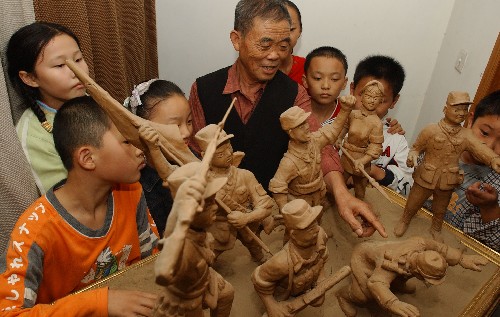Li Zhengqing: Protecting Huaibei clay sculpture legacy

Li Zhengqing shows his work Victory commemorating the 70th anniversary of the Red Army's Long March to children.
Li Zhengqing is the inheritor of the Huaibei clay sculpture art, a folk craft from Huaibei city of Anhui Province. At 79 years old, Li is no longer capable of making large art works, though he has lots of ideas for designs in mind. At such an old age, his mental and physical conditions only allow him to do some small articles, he said.
As a natural material that is easy to get, clay is malleable, so it is ideal for making crafts. Several generations of Li’s family have been dedicated to this art. Li’s relationship with clay sculptures dates back to his childhood. At that time, Li stayed around his father, who was also engaged in the art, and acquired techniques of painting and calligraphy, engraving, paper binding, as well as clay sculpture, laying a foundation for his future career. After graduating from middle school, he became a stage designer. But he never gave up creating clay sculptures, some of which received prizes in Huaibei and other places.
In June, 2014, the art of Huaibei clay sculpture was listed as an item of provincial intangible cultural heritage, and Li was recognized as its inheritor. Li then set up a workshop for the craft in the place where he used to live. It has become a base for teaching and inheriting this folk craft.
In the workshop, hundreds of art works created by him are on display, each of them of high artistic quality. People came to buy these items, but he wouldn’t sell them, because these are the fruit of his life-time efforts, and they should be left to later generations, he said. Though his children and apprentices have had significant achievements in clay sculpture, they have their own professions and pursue livelihoods unrelated to the art. This craft is facing the dilemma of losing inheritors.
In recent years, many efforts have been made to sustain this folk craft which has existed for at least one thousand years. For example, Huaibei authorities have used various ways to publicize and introduce the craft, including inviting Li to activities intended to spread the craft. Moreover, universities and schools often go to the base to study the art.
